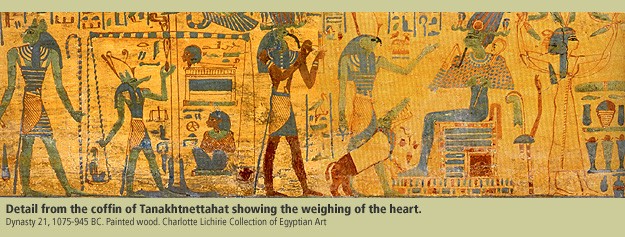In accordance with the Heliopolis creation myth, Atum was the first god to exist. The god, lonely, then decided to create the god Shu and the goddess Tefnut. The union of these two gods resulted in the birth of gods Geb and Nut. Finally, the children of Geb and Nut were Osiris, Set, Isis, and Nephthys.1
Osiris was the first ruler in Egyptian history, and he brought civilization to the land. Because of Osiris, agriculture, laws, religious institutions, and culture were given to the people of Egypt. During his reign was a time of prosperity for the ancient Egyptians. People were happy and so were the gods, except his brother Set. Set grew jealous, and resentful of Osiris’ success. Soon he began to plot his brother’s demise.2

Set threw a lavish and delicious banquet for his brother and his constituents. During the party, Set stood up and brought out a beautiful coffin, and announced a game. He told everyone at the feast that the person who could fit in the coffin could keep it. Unknown to the party attendees, Set had the coffin made to his brother’s exact measurements. One by one each of the guests attempted to fit into the coffin but were unsuccessful. Many tried to squeeze and shove themselves inside the carved box, but no one could fit comfortably inside the coffin. Finally, Osiris stood up to take his turn. As Osiris climbed into the box, Set seized the opportunity he had been plotting for. He shut and sealed the coffin with Osiris inside, and threw it into the Nile River. The river waters rushed Osiris’ living body out to sea, before finally resting in a tamarisk tree that was growing on the banks near Byblos in Phoenicia. Osiris, unable to break the seal on the coffin, struggled and fought for his life before dying in the very device intended to bury him.3
Isis, his wife and sister, was distraught by the events that transpired at Set’s feast. She decided that she would not rest until her husband’s body was found. Eventually, Isis succeeded in finding and retrieving Osiris’ body, and brought it back to Egypt. Once Isis and Osiris’ body were safely back in their homeland, the goddess then looked for a way to resurrect her beloved husband. As Isis searched for a solution, Set heard about his brother’s return. Set knew he had to act quickly, in order to make sure his plan for Osiris’ demise remained successful. Set found his brother’s body and cut it up into many pieces, and scattered them all over Egypt. Isis, upset about Set’s jealousy and interference, went on an expedition to find her husband, every piece of him. The goddess managed to retrieve all of Osiris’ body parts, except for one, to continue with her plan of revival. Isis was unable to find her husband’s penis, because it had been eaten by an oxyrhyncus fish. Regardless, Isis still managed to bring her husband back to life. During the resurrection, despite Osiris missing his genitalia, the god Horus was conceived during this time. Although Osiris was now alive and had co-created a son with his wife, he was still incomplete. Because of his missing body part he was unable to rule the land of the living. So Osiris was crowned the ruler of the Underworld.4

The word Osiris comes from the Egyptian word “Wsir.” This word can be translated to ‘powerful’ or ‘mighty’ in English.5 His job as ruler of the Underworld is to judge each Egyptian soul to determine their eligibility for the afterlife. In Egyptian art, the ruler of the Underworld is shown as being wrapped up from the chest downwards in mummy bandages. Another important feature of Osiris’ is his skin color, which is either green or black. He is typically these colors because green represents the color of rebirth and black symbolizes the color of fertility of the Nile Valley.6

Osiris judges the dead by weighing their hearts against a feather. If your heart is light, then you are allowed to pass into the Land of Two Fields. There are three requirements for entering the afterlife. First, your name had to be written down. Second, you had to have a preserved body and a tomb. Lastly, during your life you had to perform good deeds so your heart would be light enough to pass the weighing test when you met Anubis or Osiris in the underworld. The first two criteria were to insure that Ba and Ka, the two parts of ones soul, would be able to find its body each night to rest. The Ba was ones personality, and each day it would go and watch over ones family members in the land of the living. While ones Ka was a life force, it was unique to each person, and it would go each day to indulge in the Land of the Two Fields. If one lacked a written name on ones tomb or a preserved body then ones Ba and Ka would get lost and have no place to rest each night.7
- Don Nardo, Egyptian mythology (Detroit: Lucent Books an imprint of Gale, Cengage Learning, 2013), 48. ↵
- Don Nardo, Egyptian mythology (Detroit: Lucent Books an imprint of Gale, Cengage Learning, 2013), 49. ↵
- Don Nardo, Egyptian mythology (Detroit: Lucent Books an imprint of Gale, Cengage Learning, 2013), 50. ↵
- Don Nardo, Egyptian mythology (Detroit: Lucent Books an imprint of Gale, Cengage Learning, 2013), 52-53. ↵
- Salem Press Encyclopedia, January 2016, s.v. “Egyptian mythology,” by Shari P. Miller. ↵
- Robert A. Armour, Gods and Myths of Ancient Egypt (New York: American University in Cairo Press, 2001), 73, 141, 177. ↵
- Anthony Spalinger, “The Limitations of Formal Ancient Egyptian Religion,” Journal of Near Eastern Studies, no. 4 (1998): 241. ↵



94 comments
Seth Castillo
To think the entire reason why Atum created the other gods was that he was lonely. For a god to have human traits is a different approach than popular religions. For a being that is supposed to be beyond humans, to have common traits long longing and jealousy is interesting. It is very interesting to see that we changed from having gods that were relatable to having a god that is all knowing and very much not like us.
Natalia Carroll-Long
This article was outstanding. I always enjoy reading about other religious beliefs because I believe it gives real insight to how those particular people lived. That aside, this story has it all, sibling rivalry, jealousy, revenge, and determination. I like how although Osiris was drowned in a coffin and even cut into millions of pieces, because of his wife Isis’ love, he was still able to resurrect which also shows how good will always triumph evil. I would have liked have seen justice done to Set, but if they were going by the saying “don’t fight fire with fire,” I’ll understand.
Austin Pena
Great Article! I have always been interested in ancient religions, but i never knew the full story on Egyptian mythology. Reading on how Osiris became the ruler of the underworld is interesting to say the least. Since he was “incomplete” he was unable to rule the living world which i found a bit amusing, but still i see why he was named the ruler of the underworld due to his missing piece.
Isaac Rodriguez
I have always had an interest in Greek mythology, but after learning about Osiris, I will explore Egyptian mythology. One thing I find interesting is that both of the ancient civilizations, Greece and Egypt were polytheistic, and believed that their gods had a human-like form. While the story was captivating, I found it ironic that Osiris died inside of a coffin.
Belia Camarena
I think this article did a really great job describing how Osiris came to be the ruler of the underworld. It was very informative, and I enjoyed reading it. Before reading this article, I knew that Osiris was the ruler of the underworld, but I did not know that he was once alive and the ruler of Egypt. I have always found Egyptian mythology fascinating, and I thought it was fascinating that Osiris was not allowed to rule the living, since he was missing a body part.
Thomas Fraire
Very informative article! I learned a lot about Egyptian mythology in this article, I can not say I had any background knowledge on this topic coming into the reading. It is interesting to see how it ties in with the story or Cain and Able, as well as seeing Osiris become the ruler of the underworld. How he died was crazy and it is intresting how he became more powerful
Benjamin Arreguin
Egyptian mythology has caught my attention since I was younger, and not knowing where to get the majority of my information has been an issue for me. Finding an article this in depth is awesome because I get the information from the actual article, but something more valuable for me could be the citations portion of this article. Deities have been worshiped in different ways, and the cultural beliefs about heaven and hell for Egyptians is unique but very interesting. I really enjoyed this article.
Joshua Castro
What an awesome article! I have always been intrigued with both Greek and Egyptian mythology, but am more familiar with the Greek. From this article I was able to learn about the story of Osiris. I knew his brother, Set, had killed him, but I wasn’t aware that he hid his body parts all around Egypt. I also found it very interesting Osiris is depicted in hieroglyphics as green or black due to the symbolism of rebirth and fertility. This was a very intriguing article!
Christopher Martinez
This article has to be one of the most textually interesting pieces I read. Egyptian mythology is believed to be some of the earliest recorded era with hieroglyphics and writing and art through pictures. To learn that Osiris one of the earliest myths to be known and its whole story amazes me. To learn the legacy he created to only be halted by his own brother from simple jealously of everything he created shows the complex mindset of civilizations and their curiosity for stories and art through language. It amazes me how the power of stories can travel through hundreds or thousands of years and makes me wonder what is the oldest story/myth?
Peter Coons
A very interesting article. I actually found myself wanting more of this story when I finished because of how well it is written. I have always found the Egyptian afterlife an interesting topic, but whenever I read about it in my earlier school days, Osiris was a footnote compared to Anubis. I never knew this about his story, about his brother’s betrayal and subsequent disembodiment after his wife recovered his remains. I wonder how Horus came to be given Osiris’ condition, however. It’s not a big thing, just something I think should have been mentioned in regard to Horus’s mention.